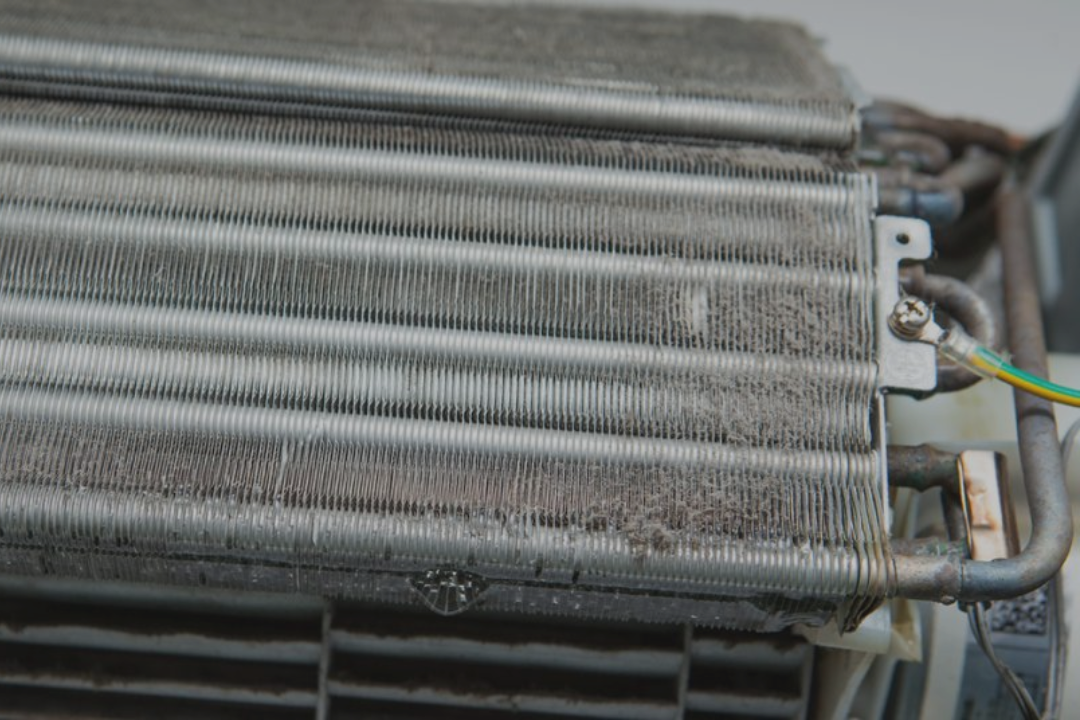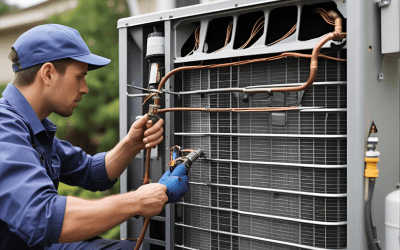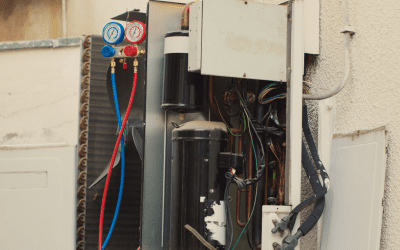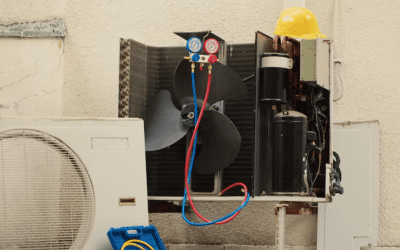The evaporator coil is one of the most critical components of an air conditioning system. Located inside the indoor unit, it absorbs heat from the air circulating through your home, allowing the refrigerant to carry that heat outside, where it can be released. When the coil becomes dirty, freezes over, or develops leaks, the cooling efficiency drops sharply. This can cause uneven temperatures, longer running times, and higher energy costs, while also straining other parts of the HVAC system.
In this blog, we’ll explore the most common AC evaporator coil problems, the early warning signs you shouldn’t ignore, and how to resolve them before they escalate into expensive repairs.
Common AC Evaporator Coil Problems
1. Dirt and Dust Accumulation
Over time, dust, pet hair, and other airborne particles settle on the coil’s surface. Even a thin layer of grime can insulate the coil, reducing its ability to absorb heat. This forces the AC to work harder and for longer periods, which increases wear and energy consumption.
2. Frozen Coils
Frozen coils occur when refrigerant temperature drops below freezing, causing moisture in the air to form ice on the coil. This is often due to restricted airflow from clogged filters, blocked ducts, or faulty fans. If you notice your AC evaporator coil frozen, it’s a clear sign that the system isn’t functioning properly and may require immediate inspection to prevent further damage.
3. Corrosion and Refrigerant Leaks
The evaporator coil is vulnerable to corrosion when moisture combines with airborne chemicals or volatile organic compounds (VOCs), forming acids that gradually eat away at the copper tubing. This can create tiny pinhole leaks that reduce the refrigerant charge, lowering cooling performance and placing the compressor at risk of damage if not addressed quickly.
4. Physical Damage
Coils are delicate, and accidental impacts during cleaning or maintenance can bend or damage the fins, which restricts airflow and lowers efficiency. It can even lead to high AC evaporator coil replacement costs.
5. Improper Sizing or Installation
If an evaporator coil is mismatched to the system’s capacity or poorly installed, it can cause persistent efficiency and performance problems, even if the coil is new.
Signs of Evaporator Coil Problems
Weak Airflow:
If the air coming from the vents feels weaker than normal or warmer than expected, the evaporator coil might not be transferring heat effectively.
Ice Formation on the Coil or Refrigerant Lines:
Frost or ice on the coil and refrigerant lines means the coil temperature has dropped too low. Airflow restrictions from clogged filters or inadequate refrigerant levels are common culprits that prevent proper heat absorption.
Water Leaks Around the Indoor Unit:
When ice on a coil melts, the excess water can overflow the condensate pan and drip near the indoor unit. Persistent moisture in this area risks water damage, encourages mold growth, and indicates a deeper cooling issue.
Don’t wait for cooling issues, get your AC coils checked now to avoid leaks, freezing, and expensive breakdowns later on.
Increased Energy Bills:
A malfunctioning coil forces the cooling system to work harder to maintain the set temperature. This extra demand increases electricity usage, driving up utility costs and adding strain to other parts of the system.
Strange Noises or Odors:
Hissing noises are often linked to refrigerant leaks, which may require professional AC evaporator coil leak repair, while a musty smell can stem from mold on the coil’s damp surface. Both issues affect cooling performance and degrade indoor air quality if left unresolved.
| Frequent short cycling or unusually long running periods often signal restricted heat transfer from dirty or damaged coils. Such irregular operation places extra stress on the air conditioner and can shorten the lifespan of its components. |
How to Fix AC Evaporator Coil Problems?
Here are the basic steps that help you understand common issues and take the right steps: –
1. Cleaning a Dirty Coil
Firstly, understand how to clean the AC evaporator coil properly. To clean the coil, first switch off the power to the unit to ensure safety. Remove the access panel and gently brush off loose debris with a soft brush. For stubborn dirt, use a no-rinse coil cleaner designed for HVAC systems. Avoid high-pressure sprays that could bend the fins.
2. Defrosting a Frozen Coil
If your AC evaporator coil is frozen, shut off the AC and allow the ice to melt naturally. Identify and correct the cause of freezing; this may involve replacing a dirty air filter, unblocking return vents, or repairing the blower fan. If low refrigerant is the culprit, a professional will need to locate and seal the leak before recharging the system.
3. Repairing or Replacing a Leaking Coil
Refrigerant leaks require professional repair. Depending on the severity, the technician may patch the leak, replace sections of tubing, or install a new coil. Continuing to run the system with low refrigerant can cause compressor failure.
4. Addressing Corrosion
Minor corrosion can sometimes be managed by applying protective coatings. For severe damage, AC evaporator coil replacement is the safest option. Preventive steps include using high-quality air filters and keeping VOC sources, like certain paints and cleaners, away from the indoor unit.
5. Straightening Bent Fins
Bent fins can be carefully straightened using a fin comb, which restores proper airflow across the coil. This is a simple but delicate task that should be done cautiously to avoid further damage.
6. Ensuring Proper Installation and Sizing
If the coil is the wrong size or was installed incorrectly, no amount of repair will restore peak efficiency. In these cases, replacement with a correctly matched coil is necessary to ensure reliable performance.
Preventive Maintenance Tips
Simple upkeep steps can extend coil lifespan, improve cooling efficiency, and help avoid costly repairs.
1. Change Filters Regularly
Replacing air filters every 1–3 months is one of the simplest yet most effective ways to protect the evaporator coil. Clean filters maintain steady airflow, prevent dust and dirt from collecting on the coil surface, reduce strain on the system, and save you from high AC evaporator coil cleaning costs. Neglecting filter changes can cause airflow blockages that lead to reduced cooling efficiency and eventual coil freezing.
2. Keep the Surroundings Clean
Clear airflow paths help the coil function efficiently and reduce the frequency of deep cleanings. So, maintain a dust-free environment around the indoor unit helps prevent debris from being pulled into the system. Vacuum the area regularly and ensure that return vents are unobstructed by furniture, curtains, or other items.
3. Schedule Professional Inspections
Annual inspections by a licensed HVAC technician are essential for long-term system health. A skilled technician can detect early signs of corrosion, refrigerant leaks, or physical coil damage that may not be obvious to the homeowner.
4. Control Indoor Humidity
In humid environments, excessive moisture can accumulate on the coil, creating a breeding ground for mold and mildew. Using a dehumidifier helps keep indoor humidity at ideal levels, reducing moisture buildup and preventing biological growth that can impact air quality and coil efficiency.
5. Avoid Chemical Exposure
Volatile organic compounds (VOCs) from cleaning supplies, paints, or stored chemicals can accelerate coil corrosion when drawn into the HVAC system. Store these products in well-ventilated areas away from the indoor unit to minimize contact with airborne contaminants that degrade coil materials.
Following these steps can help prevent most coil issues. For more details, check out our blog on a complete guide to AC repair components and cooling efficiency.
Conclusion
With these insights into AC evaporator coil problems, signs, repair choices, and maintenance practices, you’re better equipped to understand your system’s needs. Still, the most effective way to ensure lasting comfort and prevent costly repairs is to work with a trusted HVAC professional. If you are looking for AC repair services near San Antonio, New Braunfels, Boerne, or surrounding areas, Classic Air Conditioning and Heating offers expert diagnostics, reliable repairs, and efficient solutions tailored to your home. Contact us at (830) 358-1499 for any inquiry or to schedule your service appointment.






